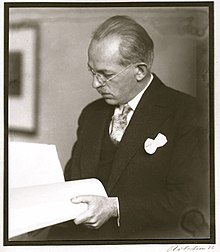Leo flower kingdom
Leo Blumenreich , actually Leonard Lewy (born September 18, 1884 in Berlin ; died May 12, 1932 there ) was a German art dealer , collector and patron .
Life
Blumenreich was born as the fourth son (of six children) of Paul Philipp Blumenreich (1849–1907) and his wife Adele (née Fränkel, 1850–1885). His father was a writer, journalist and bookseller as well as co-founder and director of the Theater des Westens in Berlin, built in 1896 . After the early death of the mother, the father married Gertrud Lewissohn in second marriage and in 1891 the Austrian writer Franziska von Kapff-Essenther in third marriage. Leo's eldest brother Arnold (1875–1943) was also a bookseller and art dealer, first in Breslau and later in Berlin. Another older brother Walter (1880–?) Ran a bookstore there.
After graduating from Luisengymnasium in Berlin on March 18, 1898, 15-year-old Leo went to New York with his father, brother and sister, where Paul Blumenreich was director of the German theater there for three years. In June 1902 Leo returned from America and moved to Vienna, where he did a four-year apprenticeship in the antiquarian book trade. Then he went to a large Parisian antiquarian bookshop for a one-year internship. In 1907 he began studying art history at the Friedrich Wilhelms University in Berlin and was a student of Heinrich Wölfflin and Max J. Friedländer , with whom he had a lifelong friendship. On Friedländer's 60th birthday in 1927, Blumenreich published a list of his writings. In 1909, Blumenreich's translation of the Rembrandt book by Jozef Israëls was published .
In 1910 he went to London, where he and the Swiss Martin Hofer (1889–?) Ran a second-hand bookshop at 47 Duke's Street, St. James's, from 1911 to 1914, specializing in Dutch and Italian primitives , as well as drawings and handicrafts. In October 1913, he married Emmy Simon-Bermann (1871–1923) in London.
In 1915 he moved to Berlin, where he was co-owner and director of the Paul Cassirer Gallery from 1916 to 1923 . There he took over the department of ancient art and developed and organized exhibitions by artists such as Max Beckmann , Oskar Kokoschka , Ernst Barlach , Martin Bloch and Edvard Munch . He traveled twice to Oslo with the art historian Curt Glaser and visited Munch's studio.
In 1923, Blumenreich acquired a plot of land in Berlin-Grunewald Wildpfad 28 and commissioned the architect Fritz Ruhemann to build a villa. On April 24, 1924 he married Hannah Cassirer, b. Sotschek (1887–1974), the ex-wife of Alfred Cassirer and mother of his stepdaughter Eva Cassirer (1920–2009). In his house he decorated the walls with works from his collection of drawings. a. by masters like Tiepolo, Rembrandt or Rubens . Leo Blumenreich donated many works of art to Berlin, which are now in the applied arts museum there , in the Bode Museum and in the Kupferstichkabinett .
In 1924 Blumenreich went into business for himself and opened his gallery at Schöneberger Ufer 37. He specialized in Dutch art as well as drawings and graphics by old masters. In April 1928 he moved to Viktoriastraße 21 . He worked with many well-known art dealers and went on numerous business trips across Europe, such as B. to Portugal with Julius Böhler, to St. Petersburg and Moscow with Fritz Catzenstein (today Galerie Matthiesen, London), as well as with G. Colnaghi and Joseph Duveen from London. In Berlin he maintained close contacts with the Goldschmidt & Wallerstein gallery. The pictures in Galerie Blumenreich were restored by Helmut Ruhemann, with whom he had a lifelong friendship.
Fonts
- as translator: Jozef Israëls: Rembrandt . Harmonie, publishing company for literature and art, Berlin 1909.
- List of the writings of Max J. Friedländer . de Gruyter, Berlin 1927.
Individual evidence
- ↑ LAB, A Pr.Br. Rep. 030- No. 9126.
- ^ Georg Wenzel: German business leader . Life courses of German business personalities. A reference book on 13,000 business figures of our time. Hanseatische Verlagsanstalt, Hamburg / Berlin / Leipzig 1929, DNB 948663294 , Sp. 220.
- ↑ L. Blumenreich, Directory of Max J. Friedländer's writings, Berlin 1927
- ↑ It was the second translation of the book. The first translation by Else Otten was under the title Rembrandt. A study published in 1906 by Concordia Deutsche Verlagsanstalt in Berlin.
- ↑ The London Gazette, January 5, 1915, p. 214.
- ^ Feilchenfeld RE and Raff T., A Festival of the Arts Paul Cassirer. The art dealer as publisher, p. 376.
- ↑ Kennert Ch., Paul Cassirer and his circle, 1996, p. 174.
- ↑ Contemporary art and architecture, architect, Dipl.-Ing. Fritz Ruhemann, Berlin 1930, pp. 4,9,10.
- ^ W. Sumowski, Rembrandtzeichnung, Pantheon, 1971, II, 3/4, p. 127.
- ↑ KdZ 9882 (Inv. 222-1919); KdZ 9883 (Inv. 223-1919); KdZ 9884 (Inv. 224-1919); KdZ 9885 (Inv. 225-1919); KdZ 9881 (Inv. 221-1919); KdZ 11732 (Inv. 94-1922).
- ↑ Nebehay, M. Ch., The golden armchairs of my father, Vienna 1983, p. 227.
| personal data | |
|---|---|
| SURNAME | Flower kingdom, Leo |
| ALTERNATIVE NAMES | Lewy, Leonard (real name) |
| BRIEF DESCRIPTION | German art dealer, collector and patron |
| DATE OF BIRTH | September 18, 1884 |
| PLACE OF BIRTH | Berlin |
| DATE OF DEATH | May 12, 1932 |
| Place of death | Berlin |


